
Cirkit Designer
Your all-in-one circuit design IDE
Home /
Component Documentation
How to Use Fermion: MEMS Smoke Gas Detection Sensor (Breakout, 10-1000ppm): Examples, Pinouts, and Specs
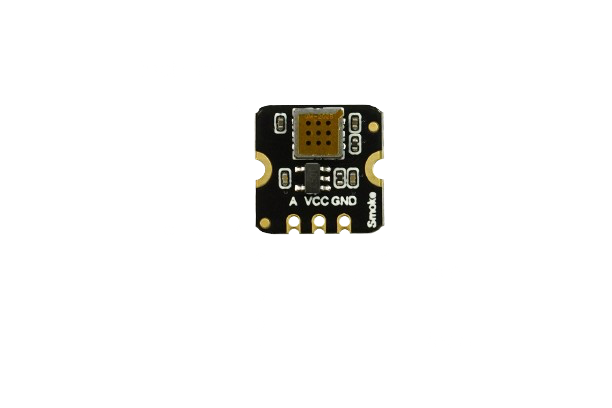
 Design with Fermion: MEMS Smoke Gas Detection Sensor (Breakout, 10-1000ppm) in Cirkit Designer
Design with Fermion: MEMS Smoke Gas Detection Sensor (Breakout, 10-1000ppm) in Cirkit DesignerIntroduction
The :Fermion: MEMS Smoke Gas Detection Sensor is a highly sensitive micro-electromechanical system (MEMS) designed to detect smoke and gas concentrations in the range of 10-1000 parts per million (ppm). This sensor is ideal for safety and monitoring applications, including fire detection systems, air quality monitoring, and industrial safety systems. Its compact breakout board design makes it easy to integrate into various electronic projects.
Explore Projects Built with Fermion: MEMS Smoke Gas Detection Sensor (Breakout, 10-1000ppm)
ESP32-Based Gas Detection System with Wi-Fi Notification
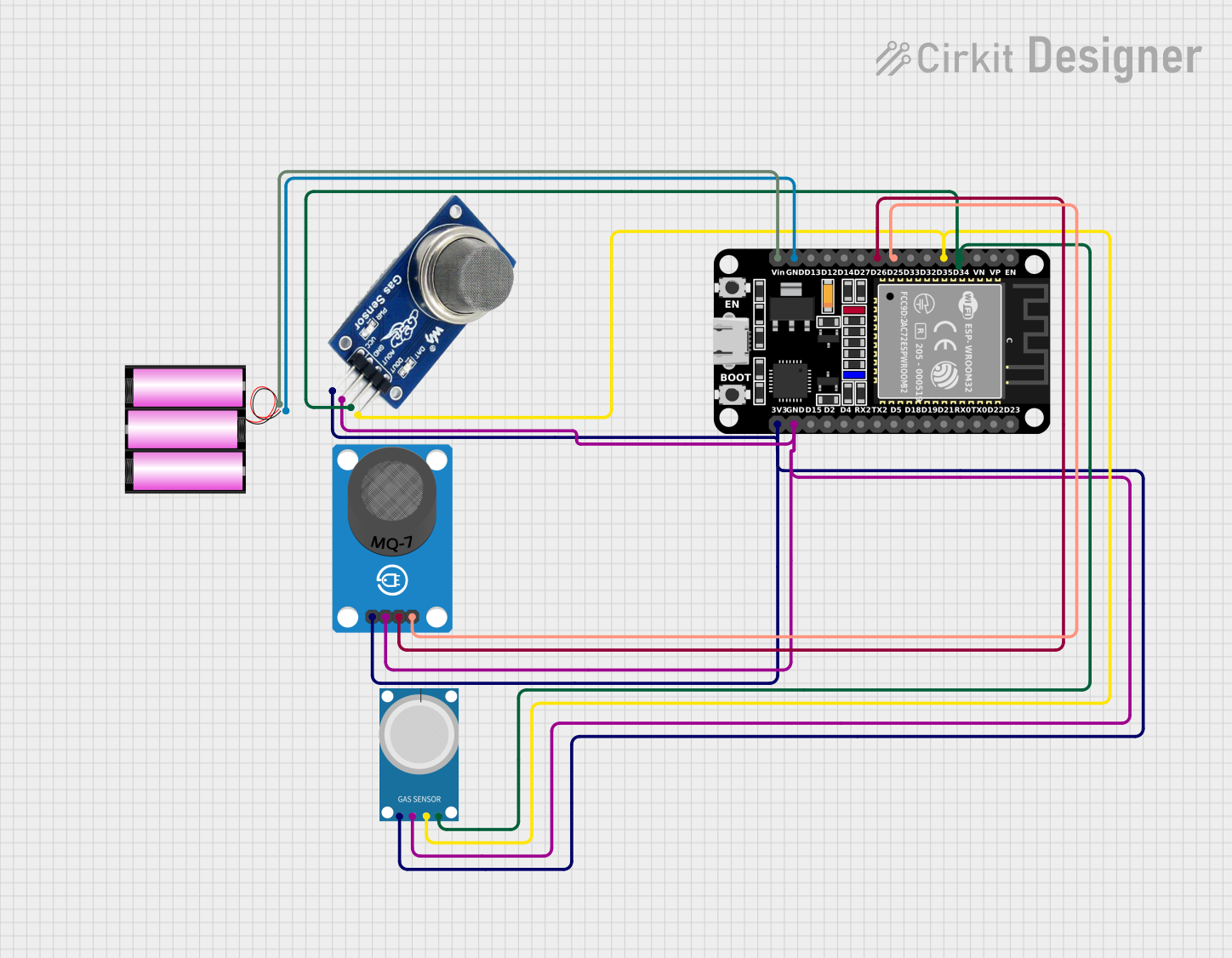
This circuit is a gas detection system using an ESP32 microcontroller connected to three gas sensors (MQ2, MQ-4, and MQ-7). The ESP32 reads both digital and analog signals from the sensors to monitor gas levels and sends notifications via Blynk if any gas concentration exceeds a predefined threshold.
 Open Project in Cirkit Designer
Open Project in Cirkit DesignerSolar-Powered Environmental Monitoring Station with ESP32 and Gas Sensors
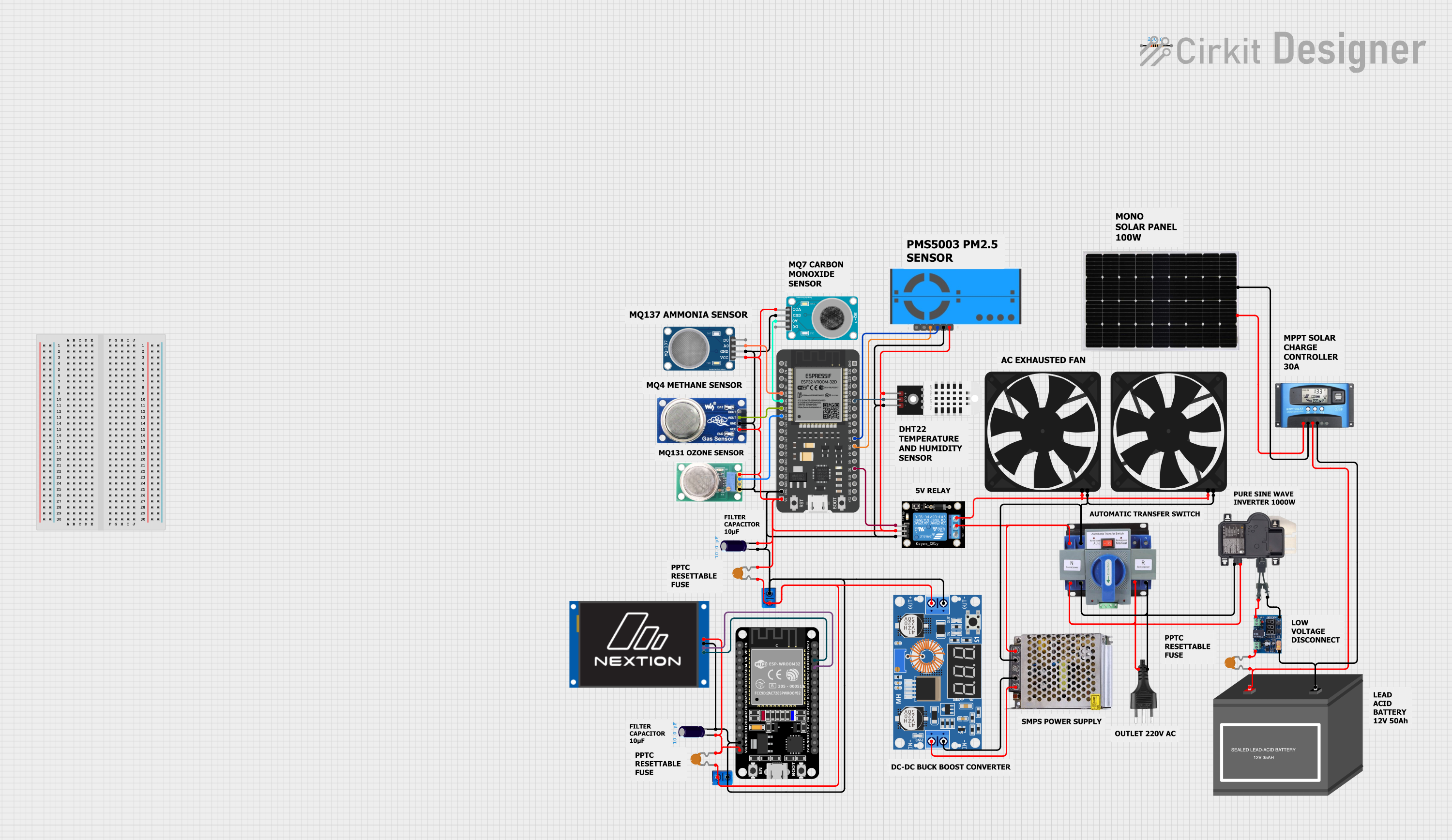
This circuit is designed to monitor various gas levels and air quality using a set of sensors (MQ-136, MQ-6, MQ-137, MQ-7, and PMS5003) interfaced with an ESP32 microcontroller. The ESP32 collects sensor data and can control a relay module potentially for activating systems like fans or alarms based on the sensor readings. Additional components include a DHT22 for temperature and humidity readings, a power supply with a step-down converter, and safety features like resettable fuses and an LVD (Low Voltage Disconnect) to protect the battery and circuit.
 Open Project in Cirkit Designer
Open Project in Cirkit DesignerESP32-Based Smart Fire and Gas Detection System with GSM and OLED Display
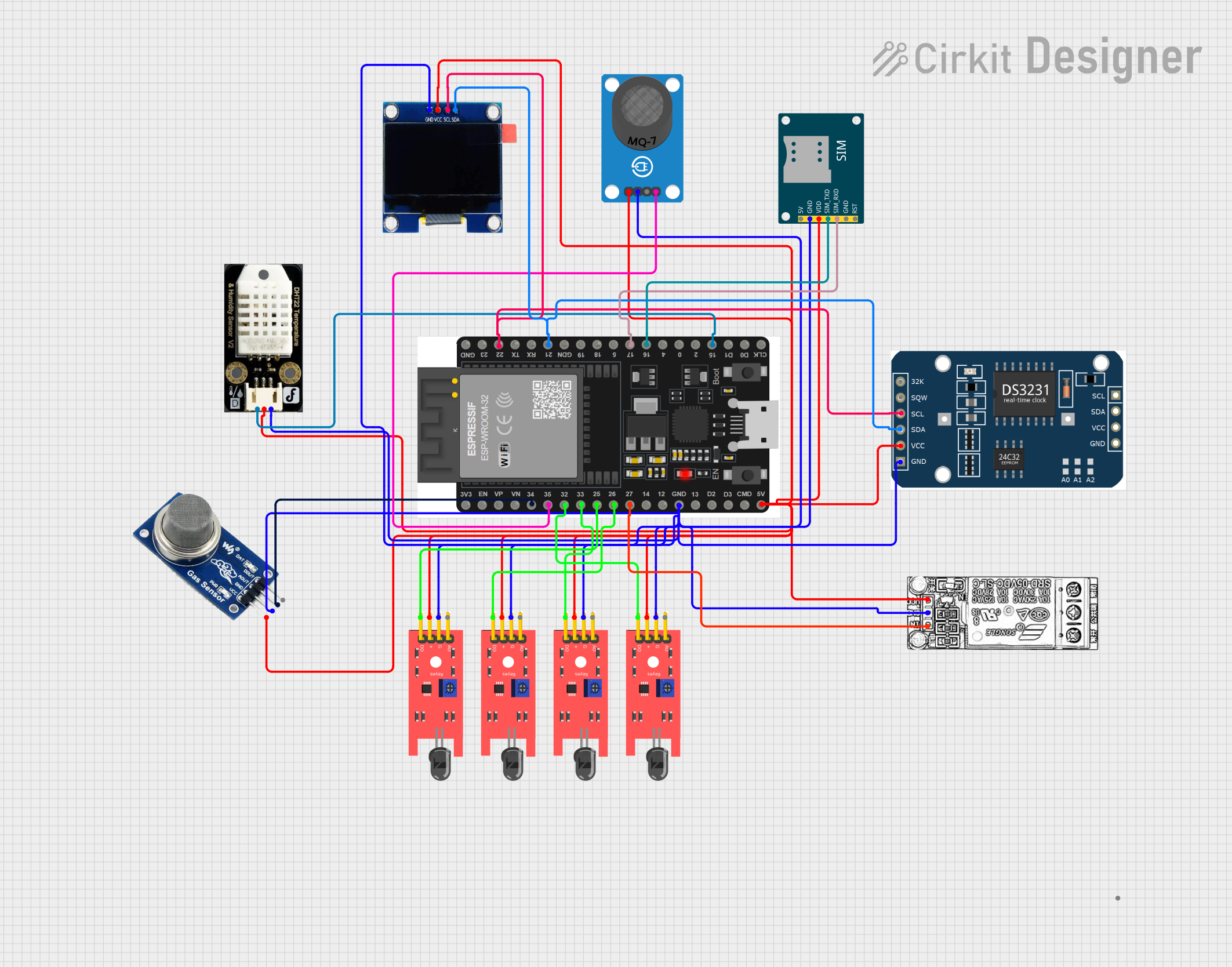
This circuit is a multi-sensor monitoring system using an ESP32 microcontroller. It integrates various sensors including flame sensors, gas sensors (MQ-2 and MQ-7), a temperature and humidity sensor, and an OLED display for real-time data visualization. Additionally, it includes a relay module for controlling external devices and a GSM module for remote communication.
 Open Project in Cirkit Designer
Open Project in Cirkit DesignerESP32 and MQ-2 Gas Sensor with Wi-Fi Notification and Battery Power
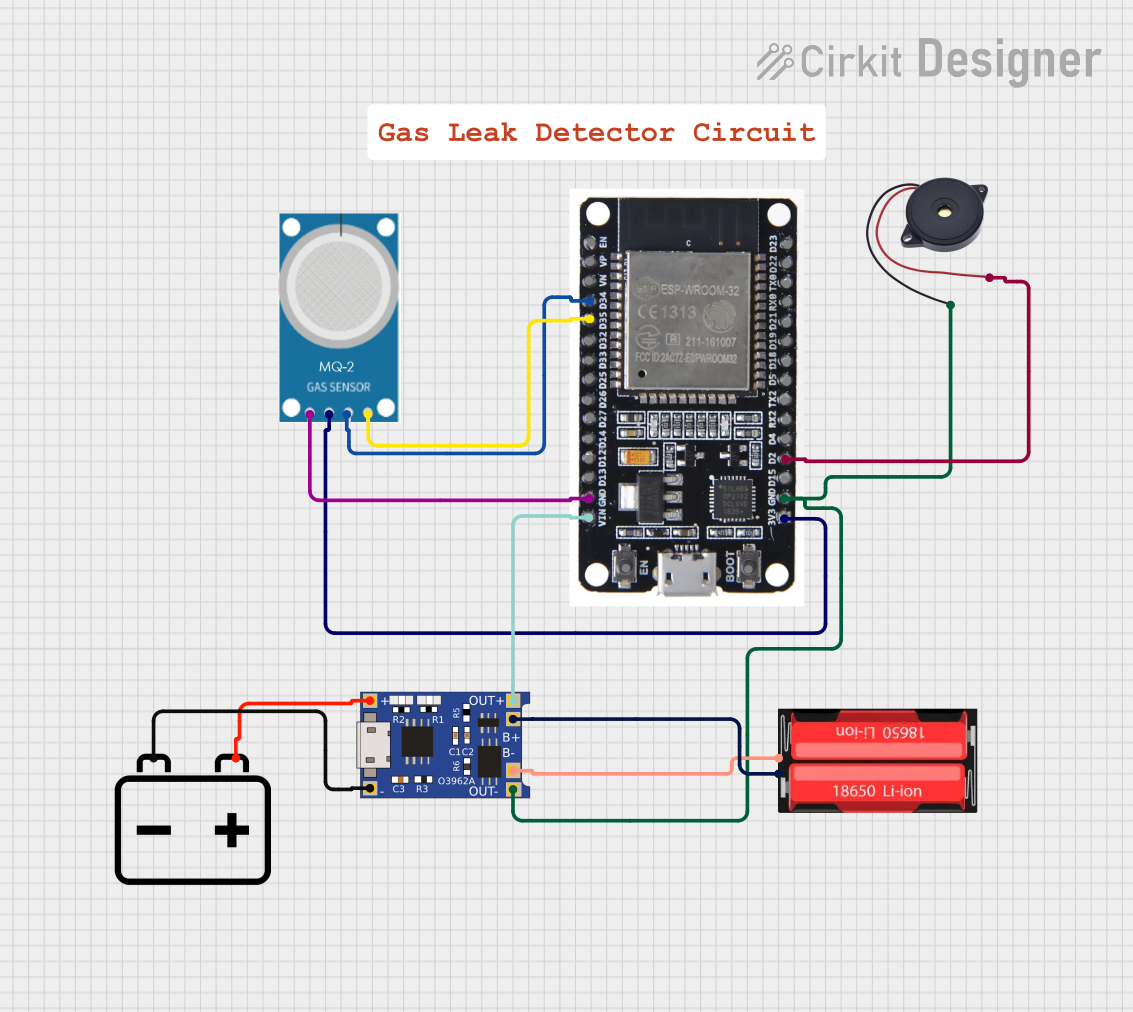
This circuit is a gas leakage detection system using an MQ-2 gas sensor and an ESP32 microcontroller. The ESP32 reads the gas levels from the MQ-2 sensor and activates a buzzer if the gas concentration exceeds a predefined threshold, while also sending notifications via the Blynk platform. The system is powered by a 12V battery and includes a TP4056 module for charging a 18650 Li-Ion battery.
 Open Project in Cirkit Designer
Open Project in Cirkit DesignerExplore Projects Built with Fermion: MEMS Smoke Gas Detection Sensor (Breakout, 10-1000ppm)

ESP32-Based Gas Detection System with Wi-Fi Notification
This circuit is a gas detection system using an ESP32 microcontroller connected to three gas sensors (MQ2, MQ-4, and MQ-7). The ESP32 reads both digital and analog signals from the sensors to monitor gas levels and sends notifications via Blynk if any gas concentration exceeds a predefined threshold.
 Open Project in Cirkit Designer
Open Project in Cirkit Designer
Solar-Powered Environmental Monitoring Station with ESP32 and Gas Sensors
This circuit is designed to monitor various gas levels and air quality using a set of sensors (MQ-136, MQ-6, MQ-137, MQ-7, and PMS5003) interfaced with an ESP32 microcontroller. The ESP32 collects sensor data and can control a relay module potentially for activating systems like fans or alarms based on the sensor readings. Additional components include a DHT22 for temperature and humidity readings, a power supply with a step-down converter, and safety features like resettable fuses and an LVD (Low Voltage Disconnect) to protect the battery and circuit.
 Open Project in Cirkit Designer
Open Project in Cirkit Designer
ESP32-Based Smart Fire and Gas Detection System with GSM and OLED Display
This circuit is a multi-sensor monitoring system using an ESP32 microcontroller. It integrates various sensors including flame sensors, gas sensors (MQ-2 and MQ-7), a temperature and humidity sensor, and an OLED display for real-time data visualization. Additionally, it includes a relay module for controlling external devices and a GSM module for remote communication.
 Open Project in Cirkit Designer
Open Project in Cirkit Designer
ESP32 and MQ-2 Gas Sensor with Wi-Fi Notification and Battery Power
This circuit is a gas leakage detection system using an MQ-2 gas sensor and an ESP32 microcontroller. The ESP32 reads the gas levels from the MQ-2 sensor and activates a buzzer if the gas concentration exceeds a predefined threshold, while also sending notifications via the Blynk platform. The system is powered by a 12V battery and includes a TP4056 module for charging a 18650 Li-Ion battery.
 Open Project in Cirkit Designer
Open Project in Cirkit DesignerTechnical Specifications
Key Technical Details
| Parameter | Value |
|---|---|
| Detection Range | 10-1000 ppm |
| Operating Voltage | 3.3V - 5V |
| Operating Current | < 20mA |
| Response Time | < 10 seconds |
| Recovery Time | < 30 seconds |
| Operating Temperature | -20°C to 50°C |
| Sensitivity | Adjustable via potentiometer |
| Output Type | Analog Voltage |
Pin Configuration and Descriptions
| Pin | Name | Description |
|---|---|---|
| 1 | VCC | Power supply (3.3V - 5V) |
| 2 | GND | Ground |
| 3 | AOUT | Analog output voltage proportional to gas level |
| 4 | DOUT | Digital output (high when gas level exceeds threshold) |
Usage Instructions
How to Use the Component in a Circuit
- Power Supply: Connect the VCC pin to a 3.3V or 5V power supply and the GND pin to the ground of your circuit.
- Analog Output: Connect the AOUT pin to an analog input pin on your microcontroller to read the gas concentration.
- Digital Output: Connect the DOUT pin to a digital input pin on your microcontroller to detect when the gas concentration exceeds a preset threshold.
Important Considerations and Best Practices
- Calibration: The sensor may require calibration to ensure accurate readings. This can be done by exposing the sensor to a known concentration of gas and adjusting the sensitivity via the onboard potentiometer.
- Ventilation: Ensure proper ventilation around the sensor to avoid false readings due to stagnant air.
- Warm-Up Time: Allow the sensor to warm up for a few minutes after powering it on to achieve stable readings.
- Avoid Contaminants: Keep the sensor away from contaminants such as dust and oil, which can affect its sensitivity and accuracy.
Example Code for Arduino UNO
// Example code to read analog and digital values from the MEMS Smoke Gas Detection Sensor
const int analogPin = A0; // Analog input pin connected to AOUT
const int digitalPin = 2; // Digital input pin connected to DOUT
void setup() {
Serial.begin(9600); // Initialize serial communication at 9600 baud
pinMode(digitalPin, INPUT); // Set digital pin as input
}
void loop() {
int analogValue = analogRead(analogPin); // Read the analog value
int digitalValue = digitalRead(digitalPin); // Read the digital value
// Print the analog value to the serial monitor
Serial.print("Analog Value: ");
Serial.println(analogValue);
// Print the digital value to the serial monitor
Serial.print("Digital Value: ");
Serial.println(digitalValue);
// Add a delay to avoid flooding the serial monitor
delay(1000);
}
Troubleshooting and FAQs
Common Issues Users Might Face
- No Output Signal: Ensure that the sensor is properly powered and connected. Check the wiring and ensure that the VCC and GND pins are correctly connected.
- Inaccurate Readings: Calibrate the sensor by adjusting the sensitivity via the onboard potentiometer. Ensure that the sensor is exposed to a known concentration of gas for accurate calibration.
- Slow Response Time: Ensure proper ventilation around the sensor. Stagnant air can slow down the response time.
Solutions and Tips for Troubleshooting
- Check Connections: Verify that all connections are secure and correct.
- Calibrate Regularly: Regular calibration can help maintain the accuracy of the sensor.
- Avoid Contaminants: Keep the sensor clean and free from dust and oil.
- Warm-Up Time: Allow the sensor to warm up for a few minutes after powering it on to achieve stable readings.
By following these guidelines and best practices, you can effectively integrate the :Fermion: MEMS Smoke Gas Detection Sensor into your projects and ensure reliable performance.